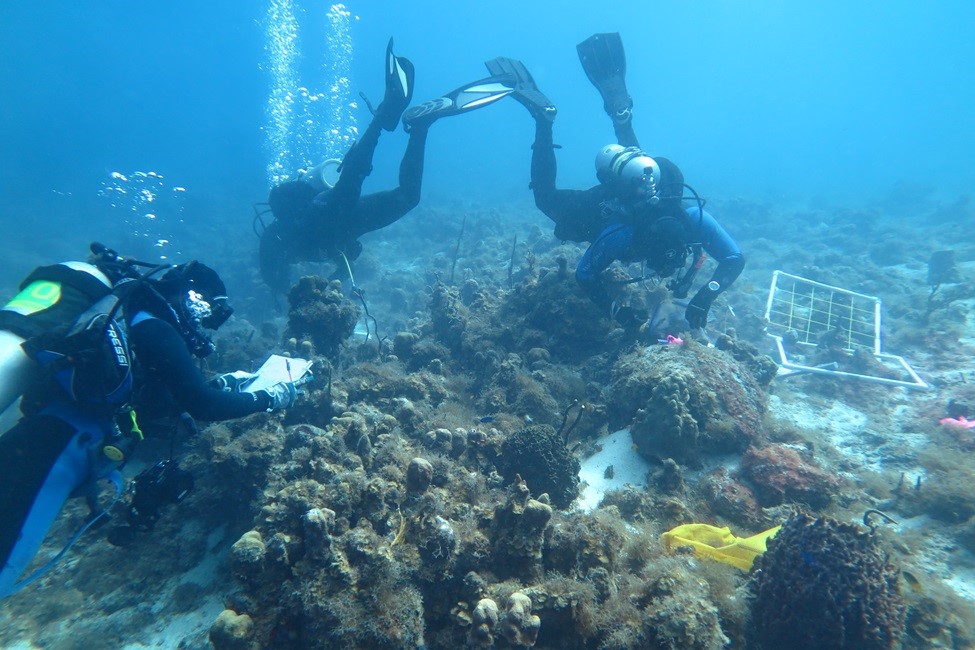Study Explores Severe Hurricanes and Coral Reef Sponge Recolonization

For the study, scuba divers collected small samples of the thin purple morphotype sponges 14 and 22 months after the two Category 5 hurricanes in St. Thomas. (Photo credit: Karli Hollister)
Named for its ropy-looking long branches, Aplysina cauliformis, a coral reef sponge, provides a critical 3D habitat for marine organisms and helps to stabilize the foundation of coral reefs. However, these upright branching sponges are highly susceptible to breaking during storms, which increases sponge fragmentation and contributes to population clonality and inbreeding.
Many sponges can survive severe damage and undergo frequent fragmentation, which is considered a mechanism for asexual reproduction. While fragmentation is a commonly utilized reproductive strategy in rope sponges, they also can reproduce sexually by producing larvae. How and whether they recolonize following extreme weather events is critical for the restoration and resilience of coral reef ecosystems.
Hurricanes Irma and Maria – both in 2017 – were two rapid succession storms that provided researchers from Florida Atlantic University’s Harriet L. Wilkes Honors College and Harbor Branch Oceanographic Institute , and collaborators from the University of the Virgin Islands, the University of Mississippi and the University of Alabama, with a unique opportunity to address a priority concern – the resilience of coral reef sponge populations after severe hurricanes.
The researchers are the first to evaluate substrate recolonization by sponges in the U.S. Virgin Islands after these two catastrophic storms using genetic analyses to understand how much clonality verses sexual recruitment occurs on coral reefs post-storms. To date, studies of storm impacts have largely focused on scleractinian or stony corals.
Results of the study, published in the journal Molecular Ecology , reveal that populations of clonal marine species with low pelagic dispersion, such as A. cauliformis, may benefit from increased frequency and magnitude of hurricanes to maintain genetic diversity and combat inbreeding, enhancing the resilience of Caribbean sponge communities to extreme storm events.
The A. cauliformis population before the hurricanes was highly clonal but shifted to greater sexual reproduction for recolonization after the hurricanes, with 85 percent of sexual reproduction mainly due to local larval recruitment. Major storm events favored sponge larval recruitment but did not increase the genetic diversity.
“Branching coral populations exposed to intermediate or low storm frequencies are known to have primarily sexual populations, whereas sites with the highest storm frequencies have mostly clonal populations,” said Andia Chaves Fonnegra, Ph.D., principal investigator and an assistant professor of biology in FAU’s Harriet L. Wilkes Honors College and Harbor Branch. “In contrast, our findings showed greater recruitment of sexually derived sponge larvae than clones arising from fragmentation/regeneration after these extreme events, maintaining genetic diversity. Because A. cauliformis sponges reproduce both asexually via fragmentation and sexually, interactions between these mechanisms may maximize their dispersal efficiency and their likelihood of successfully recolonizing habitats.”
Larval recruits (genets) and fragments (ramets) were detected at all St. Thomas sampling locations post-hurricane, indicating a potential for rapid population recovery for this species that was not affected by site physiography.
At all sites combined, 65.8 percent of the pre-hurricane adult sponges were genets compared to 85.1 percent of the post-hurricane juveniles. This suggests that recolonization of A. cauliformis after the hurricanes was largely due to sexual reproduction, with gene flow across distances up to 60 kilometers, between St. Croix and Buck Island in St. Thomas, detected among the study sites.
For the study, scuba divers collected small samples of the thin purple morphotype sponges 14 and 22 months after the two Category 5 hurricanes in St. Thomas. Researchers then extracted genomic DNA from the sponge samples using a genotyping method based on sequencing uniform fragments called 2b-RAD. This emerging method is used for mapping, population genetics, genetic mapping and estimating alleles. Genetic diversity was estimated for the pre-hurricane (adults) and post-hurricane (adults and juveniles) populations as expected (He) and observed (Ho) heterozygosities with inbreeding coefficient (FIS) and compared.
“Over short time scales, intermittent disturbances such as hurricanes can alter the structure and function of the coral reef benthic community and impact recovery time,” said Chaves Fonnegra. “However, as we have demonstrated in our study, storm events don’t affect all reef species equally and can promote diversity by creating open substrate for larval attachment and recruitment.”
Given predictions of more frequent intense hurricanes as climate continues to change, it is likely that major disturbances such as the unprecedented landfall of the two Category 5 hurricanes in St. Thomas will continue to influence the population structure of coral reef species and their ecological interactions.
Study co-authors are Iris Segura-Garcia, Ph.D., first author and a former postdoctoral fellow in the Chaves Fonnegra Lab; Julie B. Olsen, Ph.D., a professor of biological sciences, University of Alabama; Deborah J. Gochfeld, Ph.D., principal scientist, Department of Biomolecular Studies, the University of Mississippi; and Marilyn E. Brandt, Ph.D., research associate professor, University of the Virgin Islands.
This research was funded by Chaves Fonnegra start-up funds and a National Science Foundation RAPID grant (OCE-1807807, Gochfeld, OCE-1808233, Olson and OCE1810616, Brandt).
-FAU-
Latest News Desk
- FAU Researchers 'Zoom' in for an Ultra-Magnified Peek at Shark SkinWhat gives shark skin its toughness and sleek glide? Tiny, tooth-like denticles. Researchers used electron microscopy to reveal how these structures shift with age, sex, and function in bonnethead sharks.
- FAU Receives $1.6M Gift for Student Entrepreneur ScholarshipsFlorida Atlantic University received a $1.6 million gift from long-time Boca Raton resident Bob Schattner, which will be used to continue providing scholarships that he established 15 years ago in perpetuity.
- FAU Lands $3M Federal Grant to Prevent Substance Use in At-risk Youth"Rising Strong" will support more than 3,000 South Florida youth with trauma-informed, evidence-based prevention, empowering vulnerable populations to build resilience and choose substance-free futures.
- FAU Research: Logistics Expansion Slows as Transportation Prices DropThe Logistics Managers' Index had the lowest overall reading since March as the supply chain reacts to economic uncertainty, according to researchers from Florida Atlantic University and four other schools.
- World's First Bench-to-Bedside MRI, Focused Ultrasound System UnveiledThe newly expanded FAU NeuroInnovate Center is the first in the world to integrate advanced MRI and focused ultrasound technologies into a single, unified platform for both preclinical and clinical research.
- FAU College of Business to Honor Craig ZinnFlorida Atlantic University's College of Business is hosting its 31st "Business Leader of the Year" breakfast to honor the accomplishments of Craig Zinn of Craig Zinn Automotive Group.






